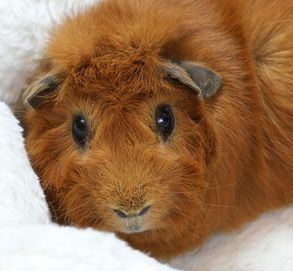
This condition is most commonly seen in female guinea pigs over the age of 3.
Symptoms of hyperthyroidism in guinea pigs include hyperactivity (common), weight loss (common), diarrhea or soft stools, rapid heart rate (inconsistent), increased thirst and urination (inconsistent), poor coat quality, and rapid breathing. Some patients may have a palpable mass on the underside of their neck.
Masses on the underside of the neck may also be caused by infection, abscess, or lymph node enlargement. Weight loss is non-specific and can be caused by a large number of ailments as well as dietary issues.
Along with a complete blood count and serum biochemistry panel, your veterinarian will recommend a total T4 test and a free T4 by equilibrium dialysis if hyperthyroidism is suspected. Radiographs may also be recommended if changes to the bones are suspected secondary to this condition. They may also recommend an ultrasound of the thyroid to look for masses or a biopsy.
Surgery can be performed to remove thyroid tumors if there’s no evidence they have already spread. Patients often need to start supplemental thyroid hormone replacement therapy following surgery. However, the most common and best treatment is radioactive iodine therapy through an oncologist to destroy the abnormal tissue. If neither is an option, palliative treatment with medications such as methimazole or carbimazole may be tried.
The prognosis is good if diagnosed early and a good response to treatment. However, the prognosis is poor in debilitated patients.
Efficacy of treatment depends on the clinical response of the patient. It can be difficult to monitor based on hormone levels but for those who are on medical treatment it is recommended to recheck thyroid hormone levels at 2 weeks of treatment then every 6 months if doing well.
Copyright © All Rights Reserved
